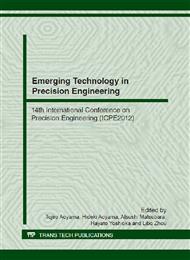p.161
p.167
p.173
p.178
p.184
p.191
p.197
p.203
p.209
Investigation of Particle Impact Phenomena in Powder Jet Deposition Process
Abstract:
Powder jet deposition (PJD) method is one of the blasting methods to generate surface coatings. The optimization of PJD conditions has been reported in our previous research. However, the deposition mechanism in PJD is still under investigation. Impact phenomena between an alumina particle with the mean particle size of 2 μm and a glass substrate has been successfully simulated by smoothed particle hydrodynamics (SPH) method. From the simulation result, we have deduced that a cubic particle is fractured by an impact, and it is adhered on to the substrate. It has been also deduced that substrate is removed by a spherical particle impact. Furthermore, PJD experiments of alumina particles blasted onto a glass substrate were also conducted. The particle size distribution of rectangular particles before and after impact was measured. It was found that the particle sizes after impact averagely became smaller than those before impact. The substrate was partly removed when spherical particles impact. From the results of the simulation and the experiment, we believe that the rectangular particles are fractured due to the impacts at the moment blasting onto the substrate, and then, firmly deposited on the substrate.
Info:
Periodical:
Pages:
184-189
Citation:
Online since:
November 2012
Price:
Сopyright:
© 2012 Trans Tech Publications Ltd. All Rights Reserved
Share:
Citation:


